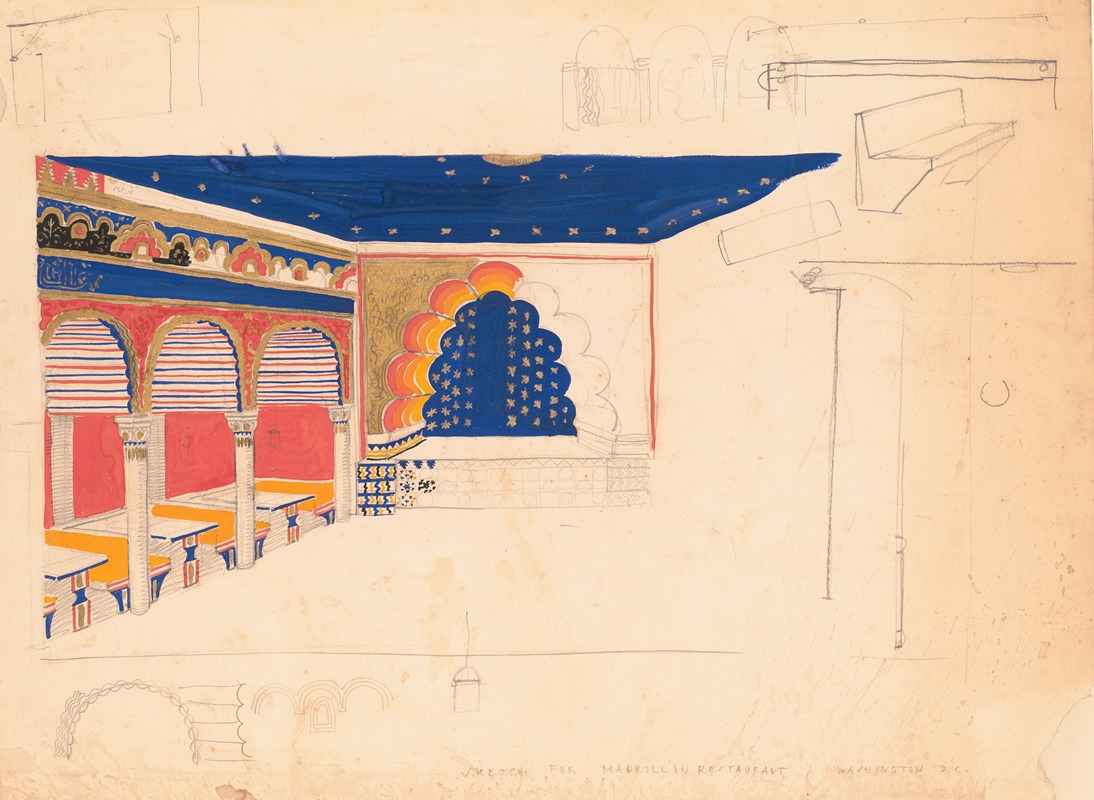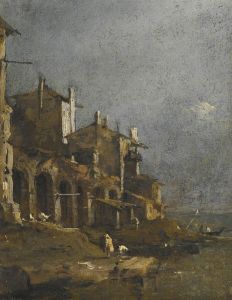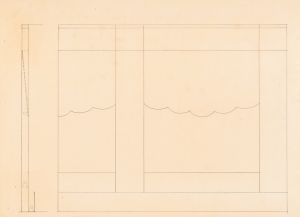
Design drawing for a restaurant , Washington, D.C.] [Interior perspective of arcade and stage
A hand-painted replica of Winold Reiss’s masterpiece Design drawing for a restaurant , Washington, D.C.] [Interior perspective of arcade and stage, meticulously crafted by professional artists to capture the true essence of the original. Each piece is created with museum-quality canvas and rare mineral pigments, carefully painted by experienced artists with delicate brushstrokes and rich, layered colors to perfectly recreate the texture of the original artwork. Unlike machine-printed reproductions, this hand-painted version brings the painting to life, infused with the artist’s emotions and skill in every stroke. Whether for personal collection or home decoration, it instantly elevates the artistic atmosphere of any space.
Winold Reiss (1886-1953) was a German-American artist known for his portraits, murals, and interior designs. One of his notable works includes the "Design drawing for a restaurant, Washington, D.C.: Interior perspective of arcade and stage." This piece is an interior perspective drawing that showcases Reiss's skill in creating vibrant and dynamic spaces through his unique artistic vision.
Reiss was born in Karlsruhe, Germany, and studied at the Royal Academy of Fine Arts in Munich. He immigrated to the United States in 1913, where he became well-known for his work in various artistic fields, including portraiture, graphic design, and interior decoration. His diverse body of work reflects his ability to blend European artistic traditions with American themes and subjects.
The "Design drawing for a restaurant, Washington, D.C.: Interior perspective of arcade and stage" is an example of Reiss's work in interior design. This drawing likely served as a conceptual plan for a restaurant's interior, highlighting the arcade and stage area. Reiss's design would have been intended to create an inviting and aesthetically pleasing environment for patrons, combining functionality with artistic flair.
Reiss's approach to interior design often included bold colors, geometric patterns, and a keen attention to detail. His designs were influenced by various artistic movements, including Art Deco and Modernism, which can be seen in the stylized and dynamic elements of his work. The use of perspective in this drawing demonstrates Reiss's ability to create a sense of depth and space, making the interior appear more expansive and engaging.
Throughout his career, Reiss worked on numerous projects that showcased his versatility as an artist. He designed interiors for restaurants, hotels, and other public spaces, often incorporating murals and decorative elements that reflected his distinctive style. His work in interior design was highly regarded for its creativity and innovation, making him a sought-after designer during his time.
Reiss's contributions to the field of interior design are part of his broader legacy as an artist who bridged cultural and artistic divides. His work remains influential, and his designs continue to be appreciated for their artistic merit and historical significance. The "Design drawing for a restaurant, Washington, D.C.: Interior perspective of arcade and stage" is a testament to Reiss's talent and vision, capturing the essence of his approach to creating beautiful and functional spaces.
In summary, Winold Reiss's "Design drawing for a restaurant, Washington, D.C.: Interior perspective of arcade and stage" is a notable example of his work in interior design. The drawing reflects his ability to combine artistic elements with practical design considerations, resulting in a visually striking and inviting space. Reiss's legacy as an artist and designer continues to be celebrated for its innovation and artistic excellence.






![[Design for mural in unidentified bar or restaurant.] [Study for mural]](/imgs/249261/s/winold-reiss-design-for-mural-in-unidentified-bar-or-restaurant-study-for-mural-93fd9e8e.jpg)
![Design for unidentified ballroom, probably New York City area.] [Perspective rendering in vermillion and gold](/imgs/249296/s/winold-reiss-design-for-unidentified-ballroom-probably-new-york-city-area-perspective-rendering-in-vermillion-and-gold-a55c65e4.jpg)
![Design for unidentified restaurant, possibly Dunhall’s Restaurant, New York, NY.] [Wall treatment, sketch 2](/imgs/249303/s/winold-reiss-design-for-unidentified-restaurant-possibly-dunhalls-restaurant-new-york-ny-wall-treatment-sketch-2-fcb08634.jpg)
![Designs for the Tavern Club, 333 Michigan Avenue, Chicago, Illinois.] [Perspective for main dining room with bay window](/imgs/249329/s/winold-reiss-designs-for-the-tavern-club-333-michigan-avenue-chicago-illinois-perspective-for-main-dining-room-with-bay-window-4b6bebcc.jpg)
![Designs for unidentified restaurant interior, possibly Elysée restaurant, 1 East 56th St., New York, NY.] [Drawing of restaurant details](/imgs/249333/s/winold-reiss-designs-for-unidentified-restaurant-interior-possibly-elysee-restaurant-1-east-56th-st-new-york-ny-drawing-of-restaurant-details-5319cbfe.jpg)
![Interior perspective drawings of Hotel Siwanoy, Mount Vernon, NY.] [Interior perspective study of Grill in red, yellow, and orange](/imgs/249369/s/winold-reiss-interior-perspective-drawings-of-hotel-siwanoy-mount-vernon-ny-interior-perspective-study-of-grill-in-red-yellow-and-orange-5860095.jpg)

![Design proposals for Puck Theater, New York, NY.] [Interior perspective study.](/imgs/249414/s/winold-reiss-design-proposals-for-puck-theater-new-york-ny-interior-perspective-study-ba0eb061.jpg)
![Designs for theater with black-framed proscenium and boldly colored settings.] [Study for stage light wall decoration, possibly for Caf ̌Crillon ……](/imgs/249421/s/winold-reiss-designs-for-theater-with-blackframed-proscenium-and-boldly-colored-settings-study-for-stage-light-wall-decoration-possibly-for-caf-crillon--2b2d7011.jpg)
![Miscellaneous small sketches for inlaid table tops.] [Design with geometric motif](/imgs/249435/s/winold-reiss-miscellaneous-small-sketches-for-inlaid-table-tops-design-with-geometric-motif-a72246b5.jpg)
![Suggested treatments of Auditorium for Theatre and Concert Hall, New York World’s Fair 1939.] [Sketch for Scheme A](/imgs/249446/s/winold-reiss-suggested-treatments-of-auditorium-for-theatre-and-concert-hall-new-york-worlds-fair-1939-sketch-for-scheme-a-e530668f.jpg)

